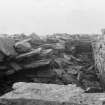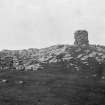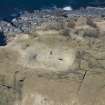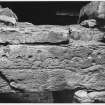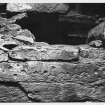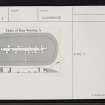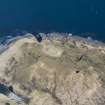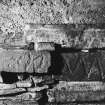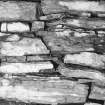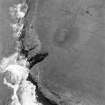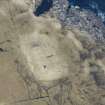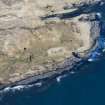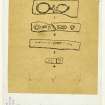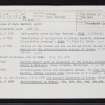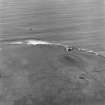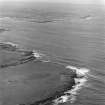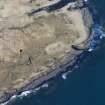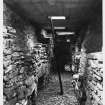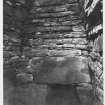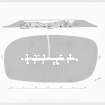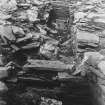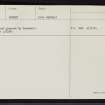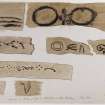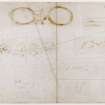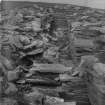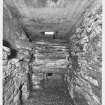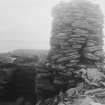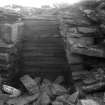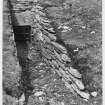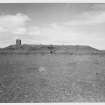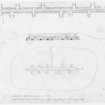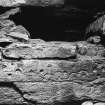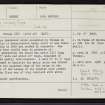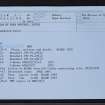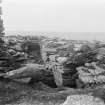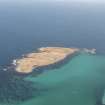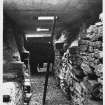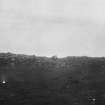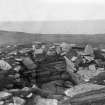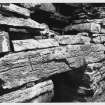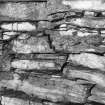Papa Westray, Holm Of Papa Westray, South
Chambered Cairn (Neolithic)
Site Name Papa Westray, Holm Of Papa Westray, South
Classification Chambered Cairn (Neolithic)
Alternative Name(s) The Disses Of The Holm
Canmore ID 3242
Site Number HY55SW 1
NGR HY 50919 51843
Datum OSGB36 - NGR
Permalink http://canmore.org.uk/site/3242
- Council Orkney Islands
- Parish Papa Westray
- Former Region Orkney Islands Area
- Former District Orkney
- Former County Orkney
HY55SW 1 5091 5183.
(HY 5091 5183) Brough (NR) (Site of) (NAT).
O.S.6"map, Orkney, 2nd ed.,(1900).
A Maes-Howe-type chambered cairn excavated by Thomas in 1849,(F W L Thomas 1852), after which it deteriorated badly until it was taken into guardianship in 1929 and roofed in concrete. The whole cairn has been turfed over to preserve it. At the time of excavation the mound was about 115' long NE-SW, about 55' wide and about 10' high, composed of loose stones and partly turf-covered. A wall 2' to 3' high which was presumed to encircle the whole cairn was traced about 6' within the apparent edge of the cairn at the entrance. Some of the stones of the chamber bear pecked decoration. The floor was of clay ovelaid with white sand.
A S Henshall 1963; RCAHMS 1946; G Petrie 1859; 1866 D Wilson 1863.
As described and planned by Henshall.
Re-surveyed at 1/2500.
Visited by OS(NKB) 1 July 1970.
Field Visit (June 1982)
The Disses of the Holm HY 5091 5183 HY55SW 1
This most remarkable monument, on the highest ground at the Send of the Holm is an elongated version of the Maes-Howe type of tomb, having no less than ten single and two double side-chambers opening off the main chamber. It is further notable for markings, now not easy to find, including an 'eyebrow motif'. The tomb was excavated in 1849 by Thomas, at which time no finds of ancient material were made. Its condition subsequently deteriorated, a graphic account of which is given by Corrie in 1928; the following year it was taken into guardianship and given a concrete barrel-roof.
RCAHMS 1983, visited June 1982.
(Thomas 1852, 127-9; Petrie 1857, 61; 1866, 222-3, 225; Marwick 1925, 46; RCAHMS Notebook, Orkney, No. 2, 11 July 1928; RCAHMS 1946, ii, pp. 186-9, No. 544; Henshall 1963, 201-2; Ritchie and Ritchie 1978, 36--7; OR 920).
Measured Survey (1983)
RCAHMS surveyed the chambered cairn at Holm of Papa Westray in 1983.
Publication Account (1996)
It is likely that, in neolithic times, Holm of Papay was not an is land but a promontory attached at the north end to Papa Westray, but even so it must be regarded as an uncommonly remote place to find one of the largest and most extraordinary tombs in Orkney. It is essentially a Maes Howe design, wth side-cells opening off a main rectangular chamber, but the enclosing cairn is oblong rather than round simply as the most economic way to encompass an enormously elongated chamber, fully 20.5m in length. The entrance-passage opens into the southeast long side of the chamber and, perhaps as a measure to strengthen the roof, there is a subdividing wall at either end of the chamber, each with a low doorway to allow access. No fewer than twelve side-cells, two of them double, are ranged round the chamber, all of them intact with lintelled entrances only 40cm to 60cm high.The roof over the main chamber is modern, and the visitor enters through a hatch and down a ladder rather than through the original low passage, although it is still complete. There are decorative carvings to discover, one on the south-east wall of the central part of the chamber, just south of the entrance, consisting of a double ring and an inverted V-motif, and three at the south-west end of the chamber, beyond the di viding wall ; on the lintel over the entrance to the south-east cell there are pecked dots and arcs, some combined to make ' eyebrow' motifs which are also to be found in Irish chambered tombs, and on the opposite wall a re zigzag and circle motifs. Nothing is known of the original contents of the tomb.
Information from ‘Exploring Scotland’s Heritage: Orkney’, (1996).
Field Visit (1998)
It is located on the highest point of the Holm, about 22m from the coast edge. The cairn is sub-rectangular in plan and measures 38m long by 19.5m wide. It is aligned north-northeast - south-southwest (Davidson and Henshall, 1989, no.22).
An entrance passage to the east-southeast side, originally some 5.5m long, leads into the main chamber. This is 13.5m long and has a cell to either end, making the overall length up to some 20.4m. Ten further cells, two of which are double cells, open off the main chamber. These are arranged in five facing pairs to either side. The tomb is thought to have contained as many as eleven stones decorated with pecking, although not all are now visible. The original contents of the tomb, which included animal bones, have been lost.
Moore and Wilson, 1998
Orkney Coastal Zone Assessment
Note (2020)
Holm of Papa Westray North
This burial site in Orkney Islands was a focus for funerary practices in the Neolithic period, between 3300 BC and 2551 BC.
Prehistoric Grave Goods project site ID: 60095
CANMORE ID: 3243
Total no. graves with grave goods: 5
Total no. people with grave goods: 13
Total no. grave goods: 22
Prehistoric Grave Goods project Grave ID: 74036
Grave type: Chamber
Burial type(s): Inhumation
Grave good: Animal Joint/Part; Materials used: Bone/Antler/Horn/Ivory/Tooth (Animal) [Antler]; Current museum location: Unknown
Grave good: Animal Joint/Part; Materials used: Bone/Antler/Horn/Ivory/Tooth (Animal) [Bone]; Current museum location: Unknown
Grave good: Animal Joint/Part; Materials used: Bone/Antler/Horn/Ivory/Tooth (Animal) [Bone]; Current museum location: National Museum of Scotland
Grave good: Animal Bone (Other); Materials used: Bone/Antler/Horn/Ivory/Tooth (Animal) [Bone]; Current museum location: National Museum of Scotland
Prehistoric Grave Goods project Grave ID: 74037
Grave type: Chamber
Burial type(s): Inhumation
Grave good: Animal Bone (Other); Materials used: Bone/Antler/Horn/Ivory/Tooth (Animal) [Bone]; Current museum location: National Museum of Scotland
Grave good: Animal Bone (Other); Materials used: Bone/Antler/Horn/Ivory/Tooth (Animal) [Bone]; Current museum location: National Museum of Scotland
Grave good: Animal Bone (Other); Materials used: Bone/Antler/Horn/Ivory/Tooth (Animal) [Bone]; Current museum location: National Museum of Scotland
Grave good: Animal Bone (Other); Materials used: Bone/Antler/Horn/Ivory/Tooth (Animal) [Bone]; Current museum location: National Museum of Scotland
Grave good: Animal Bone (Other); Materials used: Bone/Antler/Horn/Ivory/Tooth (Animal) [Bone]; Current museum location: National Museum of Scotland
Prehistoric Grave Goods project Grave ID: 74038
Grave type: Chamber
Burial type(s): Inhumation, Inhumation, Inhumation
Grave good: Pot; Materials used: Pottery; Current museum location: National Museum of Scotland
Grave good: Assemblage; Materials used: Pottery; Current museum location: National Museum of Scotland
Grave good: Bead(s); Materials used: Bone/Antler/Horn/Ivory/Tooth (Animal) [Bone]; Current museum location: National Museum of Scotland
Grave good: Unknown Object; Materials used: Bone/Antler/Horn/Ivory/Tooth (Animal) [Bone]; Current museum location: National Museum of Scotland
Prehistoric Grave Goods project Grave ID: 74039
Grave type: Chamber
Burial type(s): Inhumation, Inhumation, Inhumation, Inhumation
Grave good: Animal Joint/Part; Materials used: Bone/Antler/Horn/Ivory/Tooth (Animal) [Bone]; Current museum location: National Museum of Scotland
Grave good: Animal Joint/Part; Materials used: Bone/Antler/Horn/Ivory/Tooth (Animal) [Bone]; Current museum location: National Museum of Scotland
Grave good: Assemblage; Materials used: Bone/Antler/Horn/Ivory/Tooth (Animal) [Bone], Bone/Antler/Horn/Ivory/Tooth (Animal) [Antler]; Current museum location: National Museum of Scotland
Grave good: Point (Unknown/Unspecified); Materials used: Bone/Antler/Horn/Ivory/Tooth (Animal) [Bone]; Current museum location: National Museum of Scotland
Grave good: Point (Unknown/Unspecified); Materials used: Bone/Antler/Horn/Ivory/Tooth (Animal) [Bone]; Current museum location: National Museum of Scotland
Prehistoric Grave Goods project Grave ID: 74040
Grave type: Chamber
Burial type(s): Inhumation, Inhumation, Inhumation, Inhumation
Grave good: Animal Joint/Part; Materials used: Bone/Antler/Horn/Ivory/Tooth (Animal) [Bone]; Current museum location: National Museum of Scotland
Grave good: Animal Bone (Other); Materials used: Bone/Antler/Horn/Ivory/Tooth (Animal) [Bone]; Current museum location: Unknown
Grave good: Animal Bone (Other); Materials used: Bone/Antler/Horn/Ivory/Tooth (Animal) [Bone]; Current museum location: National Museum of Scotland
Grave good: Animal Joint/Part; Materials used: Bone/Antler/Horn/Ivory/Tooth (Animal) [Antler]; Current museum location: National Museum of Scotland
Further details, the full project database and downloads of project publications can be found here: https://doi.org/10.5284/1052206
An accessible visualisation of the database can be found here: http://blogs.reading.ac.uk/grave-goods/map/
Orkney Smr Note
This remarkable tomb - an elongated variant of the Maes Howe
type - was excavated in 1849 by Lieu. Thomas. Subsequently it got
into a very dilapidated state, a graphic account of which is given
by Corrie who saw it in 1928, shortly before it was taken into
guardianship and given a concrete domed roof. The interior is
further noteworthy for some markings, including eye-brow motifs,
on the stones. No ancient finds were made in the main or side-
chambers at the time of the original excavation.
[R1 - R7]
Information from Orkney SMR [n.d.]


























































